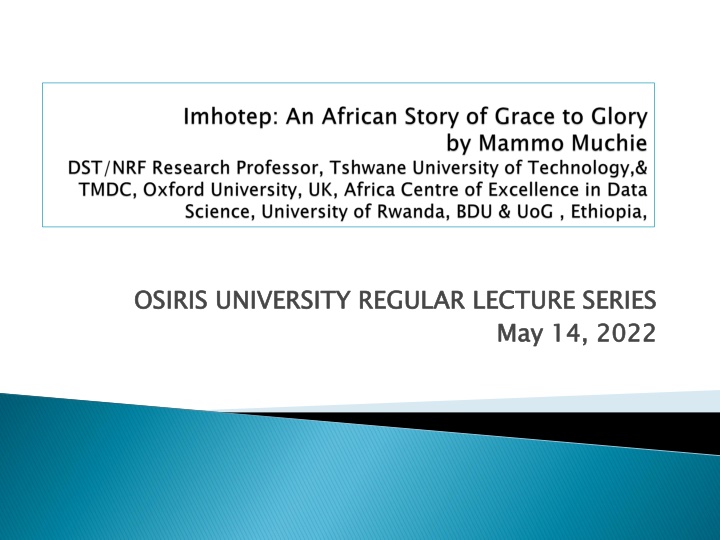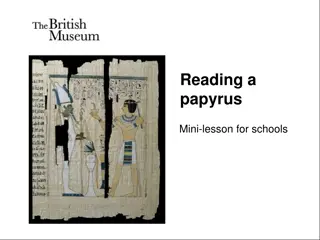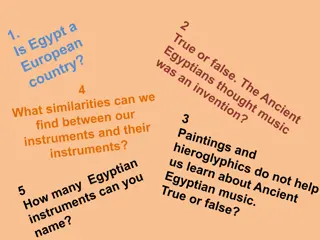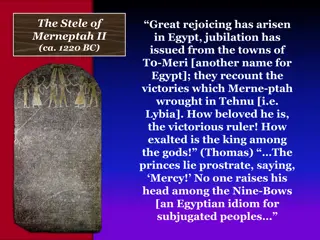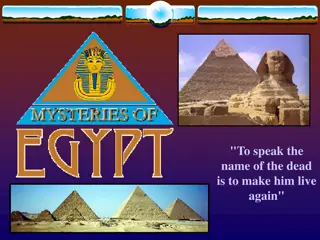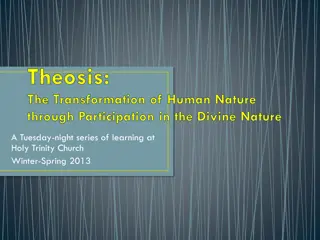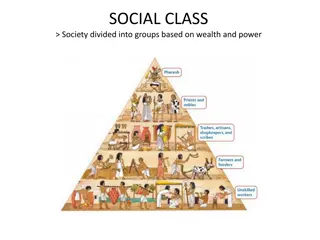Imhotep: Ancient Egyptian Polymath and Deified Scholar
Imhotep, an ancient Egyptian architect, physician, astronomer, and priest, significantly influenced the rise of Egyptian civilization. Deified as the god of medicine and wisdom, Imhotep's contributions to various fields such as medicine, architecture, and planning set him apart as a revered figure in human history. Known for his authorship of the Edwin Smith Papyrus and advancements in medical practices, Imhotep's legacy as a polymath and his impact on Ancient Egyptian Khmet civilization continue to be studied and appreciated.
Download Presentation

Please find below an Image/Link to download the presentation.
The content on the website is provided AS IS for your information and personal use only. It may not be sold, licensed, or shared on other websites without obtaining consent from the author.If you encounter any issues during the download, it is possible that the publisher has removed the file from their server.
You are allowed to download the files provided on this website for personal or commercial use, subject to the condition that they are used lawfully. All files are the property of their respective owners.
The content on the website is provided AS IS for your information and personal use only. It may not be sold, licensed, or shared on other websites without obtaining consent from the author.
E N D
Presentation Transcript
OSIRIS UNIVERSITY REGULAR LECTURE SERIES OSIRIS UNIVERSITY REGULAR LECTURE SERIES May 14, 2022 May 14, 2022
Inspiration Who is Imhotep? The age of the Pyramid Imhotep Family Background Imhotep Relation with the King Imhotep: The father of medicine Imhotep: Man of God How Imhotep Build Pyramids The Unique Pyramid Architecture Concluding Remark
Imhotep was an ancient Egyptian architect, physician, astronomer, priest, politician, and scribe of the 27th century BCE. He was one of the most influential figures in the rise of Egyptian civilization as we know it and one of the first great scholars in human history. He was later deified as the god of medicine and wisdom.
"The separation of the races is not a disease of colored people. It is a disease of white people. I do not intend to be quiet about it." Albert Einstein teaching a physics class at Lincoln University (HBCU in Pennsylvania) in 1946. The name Imhotep translates to He Who Comes in Peace , and was a polymath of high esteem, also being a poet, mathematician, and physician. The first Egyptian to be fully deified, he was later worshipped as a god of medicine after his death. There are around 200 cures and techniques attributed to him 2,200 years before Hippocrates, the father of medicine.
Imhotep is thought to be the author of the Edwin Smith Papyrus, which outlines a hundred medical terms and describes various injuries and their treatments. Imhotep was one of the first physicians to believe diseases occurred naturally and were not judgements from the gods. The papyrus contains detailed descriptions of physical conditions, with their treatments rooted in practical science. An inscription bearing his name was found on a statue of Djoser at the site of the pyramid, designating him as head of the sculptors and head of the seers. This was a sign of respect from Djoser, as previously only the names of the kings would be written on their tombs. Imhotep held many titles, starting life with little money or connections before working his way to the very top of Egyptian society.
Not all of Egypt's most influential figures were pharaohs. Let us learn about the polymath Imhotep and see just how he impacted Ancient Egyptian Khmet civilization. Imhotep was extremely educated, studying a number of disciplines, and was able to help orchestrate the growth of Khmet. He is also said to have helped save it from famine and drought through his planning and ingenuity. While he contributed to a number of fields, there are two for which Imhotep is most remembered: medicine and architecture.
If you are Christian, you go to Jerusalem If you are Judaic, you go to Israel If you are Muslim, you go to Mecca-Medina If you are Buddhist, you go to Asia If you are to know independence, you go to Ethiopia If you want to know the genius of geniuses, you go for Imhotep-the true African.
I mhotep, the man who designed the worlds first pyramid, was the vizier. He was history s first known polymath. Imhotep was the Da Vinci of the ancient world, a professional scribe, physician, surgeon, astronomer, stonemason, and architect. He left behind a wealth of knowledge that has benefited generations of engineers and doctors in the Near East and throughout the world. His medical expertise was ground-breaking and well ahead of its time. Over two thousand years after his death, people declared him a god for his many contributions to Egyptian civilization and the progress of humanity.
The Third Dynasty (2649-2575 BC) marked the beginning of a new era. With the reign of its second king, Djoser (Netjerykhet), the age of the pyramids began. Djoser s vizier (chief official) and architect, the famed Imhotep, began the experimentation in pyramid building which culminated in the magnificent Giza pyramids of the Fourth Dynasty. These pyramids provide evidence of the growing power and status of the king/pharaoh. The great Pyramid complex at Sakkara was built for Djoser. The design of the complex was unique. The design emphasised the Two Lands of Upper and Lower Egypt over which the king ruled. The 15 hectare sire was selected as it was on the edge of the western desert and overlooked the capital of Memphis.
Imhotep came from a humble background. He was born in the village of Gebelein of Thebes very little about his early life, other than that his father was an architect by the name of Kanofer. Imhotep lacked a royal upbringing but learned to read and write. He became a scribe and rose through the ranks to become the head priest of the Sun god Ra Egypt. Gebelein, south Thebes, the ancient Egyptian capital. We know Kanofer. Ra at Heliopolis Heliopolis, a city in Lower
Djoser was Egypts Pharoah during Imhoteps time. He was an ambitious man who did not want to be buried like his ancestors. Djoser requested Imhotep to design his new necropolis. Imhotep was a skilled engineer and an architect, besides being Ra s high priest. He was well-versed in the art of masonry. He used his knowledge to create the Pharoah s vision of the world s first pyramid, the Step Pyramid of Saqqara Construction in Egypt prior to the pyramid was done with mud bricks. This was the first time they employed sophisticated masonry techniques to construct a structure entirely of stones. Step Pyramid of Saqqara also known as Djoser s Pyramid Djoser s Pyramid.
The Djosers Pyramid was Imhoteps crowning architectural achievement. He may have designed an even larger pyramid, that of Pharaoh Shekhemkhet Imhotep s architectural efforts enabled future generations of engineers to create the spectacular Great Pyramid of Giza the ancient world s seven wonders. True cities grew, agriculture became more sophisticated, architecture was more advanced, and at the heart of it all, was Imhotep. Pharaoh Shekhemkhet. Great Pyramid of Giza, the oldest of
Imhotep was Egypts chief physician besides being the Pharoahs right-hand man and a skilled builder. The multi-talented genius supervised the medical treatment of the workers who built the pyramid. Egyptians regard Imhotep as the father of medicine. Inscriptions on the walls of temples in Egypt show Imhotep taking care of sick people and getting rid of their illnesses. Over two thousand years before Hippocrates produced a comprehensive list of 90 medical terms regarding the human anatomy. He also identified 48 injuries of the human body. We know this medical dictionary as the Edwin Smith papyrus purchased it in 1862. It is the earliest medical encyclopedia ever discovered. Hippocrates, Imphotep Edwin Smith papyrus. The papyrus bears Edwin Smith s name, as he
The Edwin Smith papyrus is remarkable for its time, as it is the first document to describe the structures of our skull, brain, and spine. The treatment of spinal injuries mentioned in the papyrus would be far more advanced than anything produced before modern times. Egyptologists believe Imhotep was the original author of the Edwin Smith papyrus. He knew the location of various organs in the human body and understood how the circulatory system worked. According to the renowned oncologist and Pulitzer- winning author Dr. Siddhartha Mukherjee contains the first documented reference to cancer. Scientists analyzed the remains from six mummies and found evidence of individuals suffering from cancer. It appears the physicians tried treating some of the symptoms such as ulcers. Dr. Siddhartha Mukherjee, the papyrus
Imhotep started a school of medicine in Thebes 2200 years before Hippocrates was born. He detected and cured nearly 200 ailments. 15 were abdominal, 11 were bladder related, 10 were rectum related, 29 concerning the eyes, and 18 involved skin, hair, and nails. Tuberculosis, gout, and arthritis are some diseases Imhotep successfully treated. He was not only a medical specialist, but he also conducted surgery and dentistry. Imhotep s discoveries were passed down through the generations, and that subsequent doctors could build on them. Imhotep s discoveries were passed down through the generations, and that subsequent doctors could build on them. Imhotep s discoveries were passed down through the generations, and that subsequent doctors could build on them
Although he became a personality cult, there is no denying the immense contribution of Imhotep to the progress of the human race. Future pyramid makers built on his design to create the most remarkable feat of human engineering in the ancient world, the Great Pyramids of Giza. Phoenician, Greek, and Roman physicians inherited the medical knowledge of Imhotep from the Egyptians and built upon his methods. Imhotep s contributions to the world of medicine helped future generations of Egyptian physicians develop revolutionary inventions. One such discovery was the world s first recorded pregnancy test, which was 85% accurate.
Imhoteps fame increased in the years following his death because of his work healing ailments and defining human anatomy for future generations. Egyptians revered him as the creator of healing, and he made a Demi- god a hundred years after his death. But the peak craze about Imhotep was during the Greek rule in Egypt. Greeks compared him to Asklepios 2000 years after his death, Egyptians declared Imhotep a god. He took the place of Nefterum in the triad of Memphis. The triad of Memphis comprises the god Ptah healing and wife of Ptah), and their son Nefertum After his deification, people in Egypt recognized Imphotep as Ptah s son. He became one of the few non-royal Egyptians to be deified. The people of Egypt built temples in his honor at Memphis and Philae. Patients from all over the country flocked to his temples, hoping to find a cure for their illnesses. There was a deep conviction among them that if Imhotep blessed you, you will be disease-free. The cult of Imphotep lasted a thousand years until 550 A.D. Asklepios, the Greek god of medicine. Ptah (god of creation), goddess Sekhmet Sekhmet (goddess of Nefertum.
It is believed Imhotep began as a priest in the temple of Ptah, his understanding of the will of the gods making him the most qualified person to build the pyramid which would house the Pharaoh s body for all eternity. This was a new venture: previous Pharaohs were buried in mastabas, rectangular structures with a flat roof which were built over the underground chambers where the dead were buried. The pyramid was constructed out of six masatabas built on top of one another. Imhotep changed the design to be square but had to redesign it to be rectangular. He also wanted to use stone instead of mud. This meant greater structural integrity and allowed him to build higher. There were 13 false doors cut into the stone with a 750m long trench dug into the ground. These were to discourage visitors, who would have to be told how to enter the complex. There were also mazes built into the underground chambers to protect Djoser s body. 40,000 stone vessels of different shapes and sizes were also found beneath the pyramid, inscribed with the names of previous rulers.
The pyramid design was the tallest structure of its time and had a surrounding complex made up of a temple, courtyards, shrines, storerooms and living quarters for priests. Factoring in everything within the wall surrounding the complex, it was size of a city. These methods were used in later pyramids for other Pharaohs, but its is unknown whether Imhotep himself built these or if his designs were used by others emulating his style. This is unsurprising, as the design and construction of the step pyramid stands as one of the most important milestones in architecture and engineering in human history.
His unique role is the knowledge he contributed in many disciplines Astronomy Mathematics Engineering Science Politics Religion Good to do research and demonstrate the contributions He is the originator of the unity of Knowledge
The ancient Egyptian civilization was the first of the recorded great world civilizations. Little is known about the prehistoric societies that came before Egypt but it is assumed that they were steeped in superstition and that their ability to treat disease was primitive at best and possibly non-existent. But Ancient Egypt was Khmet, Ethiopia and Africa Humanity , Science and Civilization originated from Africa Imhotep was African Let us celebrate the origin of humanity: Know that science, knowledge, innovation, medicine, astronomy, engineering, technology, mathematics architecture and philosophy originated from Africa
Let all Africans know Imhotep Their ancestors have left all the knowledge and spiritual heritage Let all build their future with pride and dignity Save the world with ubuntu With the deep heritage to make all humanity with peace and security valuing people and nature wellbeing and safety in one world community With the Health security of hope always and forever Imhotep is alive and makes all alive too!!
The Pan-African Education Commission should develop a module Imhotep s Contribution of Knowledge from Engineering and Social and Natural Sciences Osiris University should also include Imhotep s contributions in the indigenous Knowledge and Africa-centered education Development The youth must be exposed to the rich knowledge contributions from Imhotep.
Imhotep. World History Encyclopaedia. Shaw, Ian, ed. (2000). The Oxford History of Ancient Egypt. Oxford University Press. Dick Parry, Engineering the Pyramids (Phoenix: Sutton Publishing Limited, 2004)
Sincere appreciation Brother JK Osiris and the team to build Osiris University. It is also with great appreciation I salute my dearest brother Hunter Adams for sharing sources on Imhotep and Khmet. Amsegnalehu, Inkos,Asante Sana Mammo Muchie www.pati-global.com https://sarchi.org/jcise www.sarchi.org & www.nesglobal.org https://assistsarchi.wixsite.cpom/assist http://www.tandfonline.com/toc/rajs20/current https://mobile.twitter.com/ajstid1 http://www.nesglobal.org/eejrif4/index.php?journal=a dmin
